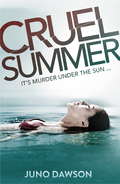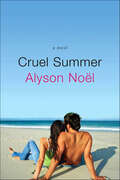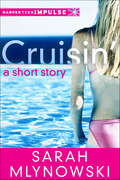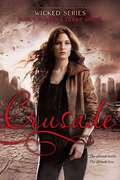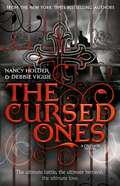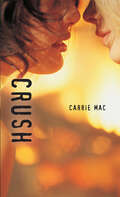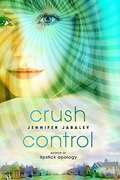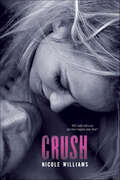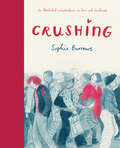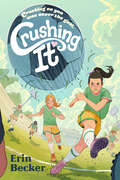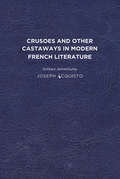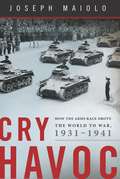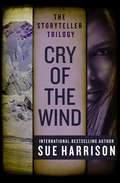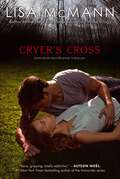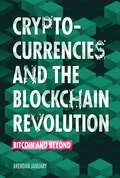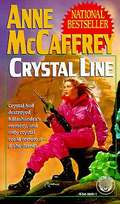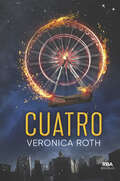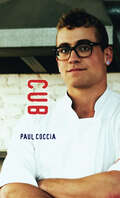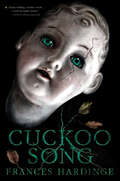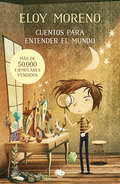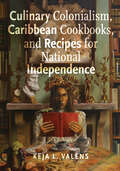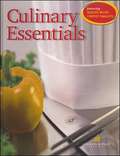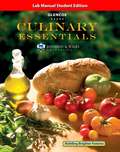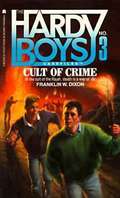- Table View
- List View
Cruel Summer
by Juno DawsonA compelling psychological thriller with a dash of romance from award-winning writer Juno Dawson. Perfect for fans of Sue Wallman and E. Lockhart.One year after the suicide of their friend Janey, the rest of the group decide to spend the summer together in a holiday villa in the Mediterranean. They're hoping to get over the terrible events of the previous year, but then a new guest arrives, claiming to have evidence that Janey's suicide was actually murder. When the guest is found dead, it becomes clear that the killer must be one of the group ... but who is it? And will they strike again?
Cruel Summer: A Novel
by Alyson Noël"This was supposed to be my best summer yet, the one I've been working toward since practically forever. Now I'm being banished from everything I know and love, and it just doesn't make any sense."Having recently discarded her dorky image--and the best friend that went with it--Colby Cavendish is looking forward to a long hot season of parties, beach BBQ's, and hopefully, more hook-ups with Levi Bonham, the hottest guy in school. But her world comes crashing down when her parents send her away to spend the summer in Greece with her crazy aunt Tally.Stranded on a boring island with no malls, no cell phone reception, and an aunt who talks to her plants, Colby worries that her new friends have forgotten all about her. But when she meets Yannis, a cute Greek local, everything changes. She experiences something deeper and more intense than a summer fling, and it forces her to see herself, and the life she left behind, in a whole new way, in Alyson Noël 's Cruel Summer.
Cruisin': A Short Story
by Sarah MlynowskiFrom the critically acclaimed author of Ten Things We Did (and Probably Shouldn't Have) and the Magic in Manhattan series comes a fun short story about taking the plunge on the high seas, where not everything is what it seems.Kristin is ready to take the next step. . . . The only problem is she hasn't found the right guy to take it with her. That's why she agreed to go on the ominously named Cruise to Nowhere with her best friend, Liz. There are plenty of cute guys on the ship to choose from if only Kristin can work up the nerve—and stop worrying about the reports in the tabloids that passengers on cruises have been mysteriously disappearing and that someone suspects it has to do with . . . vampires.Epic Reads Impulse is a digital imprint with new releases each month.
Crusade (Crusade #Bk. 1)
by Nancy Holder Debbie ViguiéVampires—the Cursed Ones—have declared war on humanity. Most people are too afraid or unwilling to take a stand, but eighteen-year-old Jenn Leitner trains to become a vampire hunter, risking everything in the process. When Jenn falls for Antonio, a vampire fighting on the side of humanity, she discovers a love that transcends attraction and physical consummation. But the closer Jenn and Antonio become, the greater the danger. Together, they must fight for their love—and to bring light into the darkness the vampires have drawn over the face of the planet.
Crusade: The Cursed Ones
by Nancy Holder Debbie ViguiéThe Cursed Ones, or vampires, have made their presence known to mankind. They promised to help bring peace to the world but then declared war on humanity. The identity of their leader is unknown. Most people are too afraid or unwillingly to take a stand against them. Others, like eighteen-year-old Jenn Leitner, train secretly to become vampire fighters and risk everything in the process. Alongside her is fellow Hunter, Antonio de la Cruz. But Antonio has a secret - he is a vampire fighting on the side of humanity. Jenn must battle with her hatred of all things vampire, and her love for Antonio. For together only they can bring light into the darkness the vampires have drawn over the face of the planet...
Crush (Orca Soundings)
by Carrie MacBecause of a moment of indiscretion, Hope's parents send her to New York to spend the summer with her hipster sister while they travel to Thailand. Miserable, Hope ends up meeting Nat, and developing a powerful crush. The only problem is that Nat is a girl. Hope is pretty sure she isn't gay. Or is she? Struggling with new feelings, fitting in and a strange city far from home, Hope finds that love—and acceptance—comes in many different forms.
Crush Control
by Jennifer JabaleyWillow has spent most of her life as her mother's sidekick in a popular Las Vegas hypnotism show. So when she and her mom move back to their sleepy southern hometown to start over, she thinks she's in for a life of quiet normalcy. Except that her new life turns out to be anything but, when she kinda sorta hypnotizes Quinton, the hottest guy on the football team, to fall madly, deeply, head over heels in love with her. But what started out as an innocent way to make her best friend, Max, jealous soon gets way out of hand, and Willow begins to wonder if the mind - and more importantly, the heart - is something you can really control.
Crush: Includes Crash, Clash And Crush (Crash #3)
by Nicole WilliamsThe conclusion to the New York Times bestselling Crash trilogy, never before published in any format!A football fantasy. A giant diamond. The modern-day Romeo and Juliet are taking their relationship to the next level. . . . Jude and Lucy are happily engaged, but that doesn't mean life's a bed of roses.Once again, the hottest couple around is torn apart, this time by football training and a summer job. Now it's Jude with the trust issues.Will Lucy's life-changing news bring them back together or end their relationship for good? Can love triumph forever?Find out in the best installment yet in Nicole Williams's racy and romantic Crash trilogy!
Crushing
by Sophie BurrowsLife is full of connections – if you know how to make them. Crushing follows two people -- one determined and a bit awkward, the other unsure where to begin -- longing to find out where they belong. Their intersecting and overlapping journeys reveal hidden connections and the unpredictable and unexpected ways we may find each other. Achingly beautiful, quietly defiant, and full of subtle wit and wisdom, Crushing is a story told in silence; a story without words but bursting with life and color. This stunning debut graphic novel from Sophie Burrows is a timely look at life in an age of distance and a story of love and understanding -- a perfect book to read and to share.
Crushing It
by Erin BeckerFrom debut author Erin Becker comes an action-packed but tender novel about first romance, queer identity, and learning how to be brave when it matters the most.On the soccer field, Magic Mel is in her element. She&’s ready to lead her team to victory at the city championship in her new role as captain. Off the field, however, is a totally different story. Mel can&’t get a handle on her class presentation, her friend group has completely dissolved, and her ex-friend-current-teammate, Tory, is being the worst. The only place she feels like herself is in her text conversations where she shares her secret poetry with BTtoYouPlease.Tory McNally, on the other hand, is keeping everything together, thank you very much. So what if her mom is more preoccupied with her craft projects and new husband than her, or that she&’s down to one IRL friend because of annoying, overly peppy &“Magic&” Mel? She&’s perfectly fine, and even when she maybe isn&’t, she&’s got NotEmilyD to text with.As the championships loom closer, everything around Mel and Tory starts to get more and more complicated: the dynamics on the field, the rift between their friend group, and, as they connect anonymously online, maybe even their feelings for each other . . .
Crusoes and Other Castaways in Modern French Literature: Solitary Adventures
by Joseph AcquistoCrusoes and Other Castaways in Modern French Literature: Solitary Adventures by Joseph Acquisto examines the many ways in which the castaway, particularly in the form of engagement with Robinson Crusoe, has been reinterpreted and appropriated in nineteenth through twenty-first century French literature. The book is not merely a literary history of the robinsonnade in France; rather, Acquisto demonstrates how what he calls the genre of “solitary adventure” becomes a vehicle for exploration of much larger questions about the reception of texts, modes of reading, and the relationship between popular and serious literary traditions. The heart of Crusoes and Other Castaways in Modern French Literature examines a crucial moment in the late nineteenth and early twentieth centuries when the history of cultural perspectives on reading and solitude intersect, catalyzing a reconsideration of Defoe’s tale. Acquisto’s philosophically inflected readings of works by writers from Rousseau to Balzac, Verne to Gide, Valéry to Tournier enhance intertextual and cultural approaches to the castaway myth and broaden our appreciation of the dynamic relation it has to modern French literature writ large. Published by University of Delaware Press. Distributed worldwide by Rutgers University Press.
Cry Havoc: How the Arms Race Drove the World to War, 1931-1941
by Joe MaioloDid the arms race of the 1930s cause the Second World War? In Cry Havoc, historian Joseph Maiolo shows, in rich and fascinating detail, how the deadly game of the arms race was played out in the decade prior to the outbreak of the Second World War. In this exhaustively researched account, he explores how nations reacted to the moves of their rivals, revealing the thinking of those making the key decisions--Hitler, Mussolini, Chamberlain, Stalin, Roosevelt--and the dilemmas of democratic leaders who seemed to be faced with a choice between defending their nations and preserving their democratic way of life. An unparalleled account of an era of extreme political tension, Cry Havoc shows how the interwar arms race shaped the outcome of World War II before the shooting even began.
Cry of the Wind: Song Of The River, Cry Of The Wind, And Call Down The Stars (The Storyteller Trilogy #2)
by Sue HarrisonIn an ancient time of icy splendor at the top of the world, can two people whose spirits belong to each other overcome the senseless violence between their tribes?A wise storyteller and powerful hunter, Chakliux has one weakness: the beautiful Aqamdax, who has been promised to a cruel tribesman she does not love. But there can be no future for Chakliux and Aqamdax until a curse upon their peoples has been lifted. As they travel a dangerous path, they encounter greater challenges than the harsh terrain and the long season of ice. K&’os, the woman who saved Chakliux&’s life when he was an infant, is now enslaved by the leader of the enemy tribe against whom she has sworn vengeance. To carry out her justice she will destroy anyone who gets in her way, even the storyteller she raised as her own son. Cry of the Wind is the second book of the Storyteller Trilogy, which also includes Song of the River and Call Down the Stars.
Cryer's Cross
by Lisa McMannKendall loves her life in small town Cryer's Cross, Montana, but she also longs for something more. She knows the chances of going to school in New York are small, but she's not the type to give up easily. Even though it will mean leaving Nico, the world's sweetest boyfriend, behind. But when Cryer's Cross is rocked by unspeakable tragedy, Kendall shoves her dreams aside and focuses on just one goal: help find her missing friends. Even if it means spending time with the one boy she shouldn't get close to... the one boy who makes her question everything she feels for Nico. Determined to help and to stay true to the boy she's always loved, Kendall keeps up the search--and stumbles upon some frightening local history. She knows she can't stop digging, but Kendall is about to find out just how far the townspeople will go to keep their secrets buried.... “Cryer’s Cross is an eerie, gripping, totally addictive, breathtaking whirl of a book with an ending that left me haunted for days. Lisa McMann has done it again—this book is unputdownable!” --Alyson Noël, #1 New York Times bestselling author of the Immortals series. "A brilliant, engaging, scary piece of fiction. Every word had me sliding closer to the edge of my seat and gripping the cover tighter and tighter. There are books in the world that make you question your reality and the things that go bump in the night--this is one of them." --Heather Brewer, New York Times bestselling author of the Chronicles of Vladmir Tod series
Cryptocurrencies and the Blockchain Revolution: Bitcoin and Beyond
by Brendan JanuaryIn January 2009, a mysterious software developer, Satoshi Nakamoto, exchanged a specially designed code with another developer. The code was a digital currency that Nakamoto had proposed several months before in a paper titled “Bitcoin: A Peer-to-Peer Electronic Cash System.” This was the first Bitcoin transaction. Since then, Bitcoin has become the face of a tech revolution in digital cryptocurrencies based on blockchain technology. Its success has sparked a tech revolution that could fundamentally change global economics. Author Brendan January delves into the world of coders, libertarians, criminals, financial regulators, and crypto-detectives to understand what digital cryptocurrencies have to offer, their limitations and potential pitfalls, security issues, and how they may affect government and financial regulations in the future.
Crystal Line (Crystal Singer Trilogy #3)
by Anne Mccaffrey"A treat for long-time McCaffrey fans, a good read and a satisfying look at one of the most haunting facets of the crystal singers' profession."LOCUS When Killashandra Ree joined the mysterious Heptite Guild, she knew that she would be forever changed. Crystal singing brought ecstasy and pain, near-eternal life...and gradual loss of memory. What she hadn't counted on was the loneliness she felt when her heart still remembered what her mind had forgotten. Fortunately, someone still cared enough to try to salvage what was left of Killashandra's mind. But she would have to learn to open herself--to another person, and to all her unpleasant memories.From the Paperback edition.
Cuatro. Un libro de la saga Divergente: Un libro de la saga Divergente
by Veronica RothEl esperado spin-off de la trilogía Divergente. Una elección lo rescatará de su pasado. Una elección marcará su futuro. Una elección desvelará el peligro. Una elección lo transformará... para siempre. Una elección lo liberará. Vuelve a experimentar el amor, el sacrificio y el peligro de la trilogía Divergente, ahora desde la perspectiva del carismático Tobias. En este esperado spin-off podrás encontrar cuatro historias: La transferencia, El iniciado, El hijo, El traidor y tres escenas más que darán a los lectores de Divergente la mirada popular de Tobias sobre distintos momentos únicos en la épica trilogía.
Cub (Orca Soundings)
by Paul CocciaIn the gay community, a young, husky man is known as a "cub," seventeen-year-old Theo fits the definition perfectly, but he is very self-conscious about his body. So when his best friend signs him up for a cooking competition at Heat, the city's newest trendy restaurant, Theo is nervous. He's confident in his baking ability and dreams of opening his own bakery one day, but he's not a chef, and he hates being in the spotlight. As Theo survives round after round, he gains the admiration of both the audience and the restaurant owner, a sexy celebrity chef known as KCC. When the owner makes it clear he is more interested in what Theo might do outside the kitchen, Theo has to decide how far he is willing to go to launch his career.
Cuckoo Song
by Frances HardingeFollowing a mysterious accident that leaves her sopping wet, Triss awakens to a world that’s eerily off-kilter. Her memories are muddled, her sister despises her, and when she brushes her hair, out come crumbled fragments of leaves. Is she going mad? Or did her accident trigger a nightmarish chain of events? In her quest to learn the truth, Triss ventures from the shelter of her parents’ protective wings into the city’s underbelly. There she encounters strange creatures whose grand schemes could forever alter the fates of her family. From master storyteller Frances Hardinge comes the unnerving tale of one girl’s struggle to confront her darkest fears in order to triumph over a world where nothing is as it seems.
Cuentos para entender el mundo
by Eloy Moreno¿Y si son las ramas las que mueven el viento? Para todos aquellos que siguen siendo niños, aunque los adultos les obliguen a disimularlo. El autor de Invisible llega con este libro de cuentos que ya lleva más de 50.000 ejemplares vendidos. «Durante estos años los lectores me habéis dado tanto que me sentía en deuda con vosotros. Por eso he decidido yo también entregaros una parte de mí. Estos textos que os traigo han modelado de alguna manera mi forma de ser. Son pequeños cuentos, ya casi perdidos, de grandes autores que he decidido adaptar a los tiempos que corren. He modificado personajes, situaciones, el lenguaje... pero la esencia sigue siendo la misma: esa que nos ayuda a entender el mundo.»Eloy Moreno
Culinary Colonialism, Caribbean Cookbooks, and Recipes for National Independence (Critical Caribbean Studies)
by Keja L. ValensWomen across the Caribbean have been writing, reading, and exchanging cookbooks since at least the turn of the nineteenth century. These cookbooks are about much more than cooking. Through cookbooks, Caribbean women, and a few men, have shaped, embedded, and contested colonial and domestic orders, delineated the contours of independent national cultures, and transformed tastes for independence into flavors of domestic autonomy. Culinary Colonialism, Caribbean Cookbooks, and Recipes for National Independence integrates new documents into the Caribbean archive and presents them in a rare pan-Caribbean perspective. The first book-length consideration of Caribbean cookbooks, Culinary Colonialism joins a growing body of work in Caribbean studies and food studies that considers the intersections of food writing, race, class, gender, and nationality. A selection of recipes, culled from the archive that Culinary Colonialism assembles, allows readers to savor the confluence of culinary traditions and local specifications that connect and distinguish national cuisines in the Caribbean.
Culinary Essentials (Culinary Essentials Ser.)
by McGraw-Hill Staff Johnson and Wales University StaffCulinary Essentials offers all the ingredients for a successful foodservice training program!
Culinary Essentials, Lab Manual
by Paul J. Mcvety Bradley J. Ware Deb BettencourtNIMAC-sourced textbook
Cult of Crime (Hardy Boys Casefiles #3)
by Franklin W. DixonFrom the back of the book: Enjoy a little peace and murder High in the untamed Adirondack Mountains lurks one of the most fiendish plots Frank and Joe Hardy have ever encountered. On a mission to rescue their good friend Holly from the cult of the lunatic Rajah, the boys unwittingly become the main event in one of the madman's deadly rituals-human sacrifice. Fleeing from gun-wielding "religious" zealots and riding a danger-infested train through the wilderness, Frank and Joe arrive home to find the worst has happened. The Rajah and his followers have invaded Bayport. As their hometown is about to go up in flames, the boys look to Holly for help. But Holly has plans of her own, and one deadly secret....
